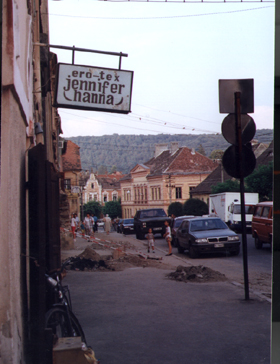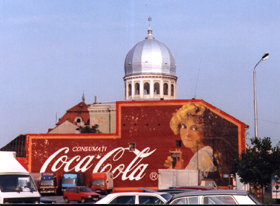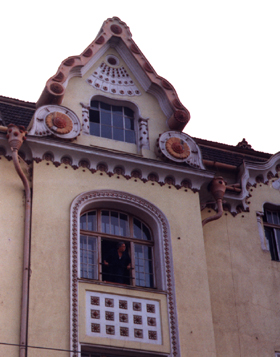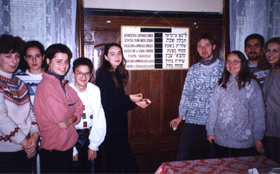

Return, Reentry and Rebound
The remainder of my Romanian sojourn was somewhat anticlimactic (and how couldn't it be). Suddenly freed from the OB framework, I found myself alternately relishing the role of ordinary Western tourist and missing the old gang. But Sighisoara was a fine place to decompress. As the central Transylvanian home town of Vlad "The Impaler" Tepes, the historical Dracula, it's a natural tourist magnet: Drac's birthplace is now a restaurant/pub where bad paintings are hawked in the immediate vicinity, "I [heart] Dracula" bumper stickers are sold in the shops, and the local entertainment newspaper is named for the favorite son. But despite all this, Sighisoara remains one of Transylvania's most picturesque towns and its local charm has survived intact (undead?). Sighisoara was formerly a stronghold of the Saxons -- ethnic Germans whose ancestors settled in Romania during the Middle Ages, nearly all of whom have decamped for Deutschland since '89. I busied myself with exploring the medieval Citadel and seventeenth-century buildings, and a covered wooden staircase that put me in mind of the earliest traces of Anglo settlement in New England.
The following morning, on the 18th, I actually found a cybercafé in Sighisoara (run by a Christian school based in Quincy, Mass., no less); the Compaq 286s were as slow as cold honey, but I was still able to access the latest news from back home, including Bill Clinton's televised apology-cum-confession in l'affaire Lewinsky, ooowee.

Around noon I boarded a surprisingly comfortable train from Sighisoara to Arad, near the Hungarian border. The train pulled out exactly on time. My compartment-mate was an erudite German professorial type traveling to Munich, and in the course of our conversation he took me for a Slovene who spoke good English and I saw no reason to disabuse him. The train kept right on schedule, moving through open green fields...
Arad
Wednesday, August 19: Walking the gritty streets of this ##$%*@'d up burg, I passed a concrete Victorian monstrosity that looks like Dracula's summer cottage. It's about 85 in the midday heat. There's a 220-year-old Citadel in town, but it's still in use as an army base and is off limits. Outside the gates is a modest monument to five soldiers killed during the riots of December 22, 1989. Vhat a country.
On the surface, or even a bit below, Arad, near the Hungarian border, is a disaster of a small city, but I felt, or thought I felt, a kind of lower-Manhattan or west-Brooklyn vibe, a stimulating urban realism, as if creativity was happening not far away, which, to an extent, is actually the case. If Arad isn't exactly the center of a new Eastern European renaissance, it was a pleasant surprise; there's a definite, if struggling, artistic presence here along with intelligent, aware people. There are a number of artists resident in Arad; many locals migrate farther afield, or at least to swingin' Timisoara an hour away, but a few stay put.
In a Romanian framework, Arad may be Oakland to Timisoara's San Francisco -- the unsung, ugly-duckling stepsister that nevertheless is home base to some interesting people living unglamorous but worthwhile lives. Too bad that not too many people outside of Romania (or even within it) seem to know this. On some level, though, I have to admit that I like it this way -- having a whole city as my secret. (Exhibit A: Ljubljana. Actually, I did email Lonely Planet a tidbit about Arad, and they put it on their web site and sent me a gratis guide, thanks, and now here's the scoop up on mine; thus my journalistic instincts battle my selfish impulses, which is a good thing, I think.) Some people even seem to be getting rich here, or at least holding on to what they have: one house boasts a slick, modern facade, locked behind a steel gate, contrasting conspicuously with the surrounding poverty. Romania, Romania...
Back in my hotel room I switched on CNN, and again connected with the outside world -- another bombing by the "Real IRA" in Northern Ireland; Clinton and family off to the silly old Vineyard again (true confession: despite having lived most of my adult life in Massachusetts, to date I have never set foot on either Martha's Vineyard or Nantucket, and don't really care. I have no psychiatrists or college professors in my family, thank God).
I chat with friendly red-haired Romanian Ramona at the funky, worthwhile Delta Gallery, where I buy a beautiful, nearly five-inch-high rendering of a molar in glass for about $13. Ramona tells me that Italian men have been coming to her country lately to scope out candidates for 'traditional' wives, since Italian women seem to have been becoming overly emancipated lately and won't stand for all the cooking/cleaning/barefoot jazz anymore, and Italian is easy for Romanians to learn. As a result, she says, "Italian women hate Romanian women!"
Due to a bridge being out on the railway line between Arad and Timisoara, an hour south, and my increasingly heavy luggage weighing on me, I decided reluctantly to bag Timisoara (giving myself a good excuse to return in November) and headed north to Oradea instead...

Oradea and Hungary
Oradea is home to an astonishing collection of turn-of-the-century Secession (Central European art nouveau) and Hapsburg-era buildings that, although surpassing in grandeur any comparable structures in Ljubljana, are in an advanced state of decay. The Austrians, Slovenes or Czechs would have worked miracles with this raw material, but the reality of the beauty shining through the decrepitude makes them even more memorable. The Vultural Negru (Black Eagle/Vulture) complex -- where I stayed, in the atmospheric hotel to blow away all competition, for about $9 for the night -- beggars description, with its huge stained-glass windows and swooping, ornate staircases, yet the adjacent, equally magnificent arcade is home to shoddy, charmless shops and wandering vagrants. Romania is a raw place: raw as in raw beauty, and raw as in raw -- as yet uncooked by Western Euro-merican values. The flavor is real and the flavor remains.
Be that as it may, I decided that one night in this place was enough. It was time to be heading home. And so back to Hungary, to sunflowers and cornfields. It looked prosperous. Not depressing at all.
Reentry: Budapest
Among the greatest culture shocks I've ever had in my life, easily equaling my first days in Slovenia in 1996, was traveling from rural Romania back to the West, represented by Budapest, which, to me at that point, might as well have been Manhattan. ATMs. Modern fashions. Marks & Spencer. Americans and Brits and Japanese tourists with videocams. Jostling and being jostled.

August 20 is Hungary's National Day, to boot, and the banks of the Danube are packed with aimless late-summer crowds strolling, buying, eating and listening to pure junk. The market stalls vend all manner of impulse-buy overpriced (at least for here) crap. I wade into the crowd, find a stall selling kürtös cones and, munching on one, think wistfully of Praid and Székely land. (No offense, but I have to say that I find the Hungarians much more interesting as a minority than as a majority.) I grab a plate of grilled veggies from another stall and end up with ice cream and espresso in a slick café on Váci útca, the main street for shopping, strolling, and staring at other tourists. I also shop for tapes and CDs, bringing myself back to city life.
At my Budapest hotel, I'm impressed at the softness of the toilet paper. Coming from the States, I'd have been appalled. (Ah, toilet paper again.) Everything is relative. Romania is both appalling and precious to me now, and ever-haunting.
I hear distant thunder on Váci útca. At ten minutes past seven p.m., what seemed like at least a hundred rollerbladers thundered down the wide pedestrian boulevard. I took refuge near a storefront until the storm passed.
Eventually, I re-acclimatized to civilization. Sort of. Perhaps too much.
Friday, August 21 [diary entry]: Very pleasurable day in B'pest, especially the morning, when I kept my promise to myself [made during one of the excruciating OB hikes] and had a swim, soak, shvitz and steam at the touristy but wonderful Gellért Baths. Spent the afternoon shopping, mostly for Tokaji Aszú (two pricy bottles, at the Boutique des Vins and the House of Hungarian Wines) with stops at the Food Hall for lunch and the Café Ruszwurm for ice cream. And bought a ticket back to Ljubljana.
And so ended the summer vacation where, as one of the campers -- it may have been T.V. -- remarked to me at one point, "you went back to your childhood with eight stupid guys!" And found out that it wasn't too late.
P.S. -- Go again? Are you nuts?
As for Timisoara...
Believe it or not, that wasn't the end of my Romanian adventures in 1998. Late that October, feeling a need for closure or completion against logic, I returned, this time to Timisoara, the westernmost city in Romania by attitude as well as compass point.
When he visited Timisoara, Balkan Ghosts author Robert D. Kaplan was bored and dismissive: "I no longer felt that I was in Romania," he wrote. To Kaplan, Timisoara belonged more to the West than the Wild East, or even Transylvania (where the Saxons' legacy of industriousness rubbed off on the locals over the centuries). Arguably so, but I judged Timisoara a fine place to visit on its own merits -- legacy of a flawed revolution and all.
Wednesday, October 28 [diary entry]: Arad, Hotel Ardealul. OK, truth is in the details. The top of the plastic toilet seat in the bathroom in my room is detached. On the wall, the single decoration (on purple flocked wallpaper) is a '70s vintage print of downtown Bucharest, depicting Piata Universitatii and the Hotel Intercontinental. When I turn on the bathroom sink, water leaks out from underneath, onto the floor...the foyer light is out. The room's nice and quiet, though, the ceilings are high. There used to be a concert hall where Liszt, Brahms, J. Strauss (Jr.) and Casals played...The bathroom towels are thin and rough-textured, of course...the towels and carpets smell of nasty cleaning liquid...the shower nozzle dribbles forth tolerably warm water.
Leaving a country, one tends to forget these little breakdowns and inconveniences and remember, what -- general moods? Acts of kindness or cruelty or indifference that stand out due to a person's individual wiring.
[Another] historic concert hall was a movie house for awhile; now it's the Club Viva Disco. The narrow street is choked with Dacias [Romania's domestic hunk-of-junk autos] all day long, spewing toxic fumes...
That said, the contrast between my activities that summer and the following fall were striking. Instead of backpacking, bicycling, bivouacking in the rain, kayaking, rappelling, canyoning and climbing mountains, in Timisoara I occupied my time visiting art galleries and artists' studios, attending a play at the Opera House, sampling the local cuisine, touring the landmark Metropolitan Cathedral (witnessing a Halloween wedding) and the ramshackle, fascinating Banat Museum, and paying a visit to the local Jewish community center, the "Cantina" (a thriving and delightful place; some of its younger members are shown at right). I stayed at a shabby but comfortable central hotel (named, of course, the Hotel Central), where my bill came to a grand total of 720,000 lei for four nights, which at the time was a bit over $76.

For more on Romania's "first free town," click here to read my piece on Timisoara, published in the travel section of the Sunday LA Times on September 5, 1999. (Unfortunately, you'll have to pay the LAT to read more than three paragraphs, but I'll tell you this much: of all the leads I've ever written in my journalism career, I'm happiest with and proudest of the one that begins this article. The LAT even used a couple of my photographs in the piece, to boot.)
Disclaimer and the Final Word: This journal is as accurate as I could make it, based on diary entries and other notes I jotted down at the time. However, memory is a jokester and my apologies for any inadvertent errors or inaccuracies that got through. Special thanks are due to Orsi for her help in getting the names straight (Hungarian diacritical marks and all). Where dual Hungarian and Romanian place names exist for Transylvanian towns and cities, for consistency's sake the Romanian name has been used (no political or ethnic preferences are implied), with the exception of Korond; I suppose that's because "Korond" and not "Corund" is what's scrawled on the bottom of the ceramic pieces I bought there, along with the craftsman's initials.
Comments and corrections (especially by those who went along on the trip, to whom this bit of cyberspace is dedicated) are very welcome: post in the guest book, or e-mail me at wes (at) p0g0er.org (using o for 0).
My sincere thanks and admiration go out to everyone at Outward Bound Romania, and to the people I met along the way -- as well as anyone who's read this all the way through.
Ljubljana, August 1998 - March 2000
(c)2000-2006 Wes Eichenwald/Double Shot Productions. Reproduction in whole or part by any means, printed or electronic, is strictly prohibited without express permission of the author.